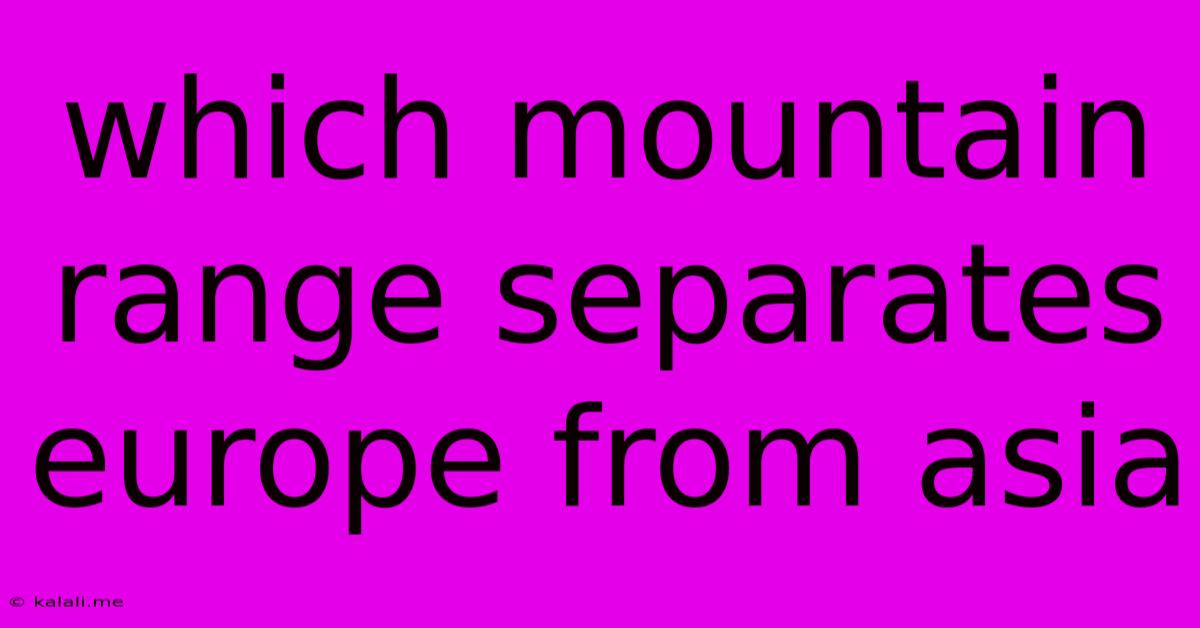Which Mountain Range Separates Europe From Asia
Kalali
Jun 15, 2025 · 3 min read

Table of Contents
Which Mountain Range Separates Europe from Asia? The Ural Mountains and More
The question of which mountain range separates Europe from Asia is deceptively simple. While the Ural Mountains are commonly cited as the primary geographical boundary, the truth is more nuanced and involves a combination of geographical features and historical conventions. This article will delve into the complexities of this geographical divide, exploring not only the Ural Mountains but also the Caucasus Mountains and the various other factors that contribute to the definition of the Europe-Asia border.
This article will explore the Ural Mountains, delve into the role of the Caucasus Mountains and the Caspian and Black Seas, examine the historical and political implications of the border, and even touch upon alternative perspectives on the continental divide.
The Ural Mountains: The Conventional Boundary
The Ural Mountains, stretching roughly 2,500 kilometers (1,600 miles) from the Arctic Ocean to the Ural River, are often considered the primary divider between Europe and Asia. This is largely due to their prominent, linear feature which forms a relatively clear natural boundary. Their geological significance, representing a long-standing geological fault line, further reinforces this viewpoint. The range is relatively low, with peaks rarely exceeding 1,800 meters (5,900 feet), but their considerable length makes them a significant geographical landmark. Geographers often use the Ural Mountains as a reference point, considering the area east of them to be part of Asia.
The Caucasus Mountains: A Complicated Addition
The Caucasus Mountains, located south of the Russian Plain, present a more complicated case. This mountain range acts as a significant natural barrier, but its inclusion in either continent is a matter of debate. Geographically, the Caucasus Mountains continue the geological features of the Ural Mountains; however, historically and culturally, they have complex ties to both Europe and Asia. Parts of the Caucasus region are frequently considered to be part of Europe, whilst other areas are firmly considered to be within the boundaries of Asia. This complex political, social and geographical situation leads to confusion regarding whether the Caucasus Mountains define part of the boundary between the two continents.
Beyond Mountains: Rivers and Seas
Beyond mountain ranges, other geographical features play a role in defining the Europe-Asia border. The Ural River, flowing south from the Ural Mountains, is often considered part of the boundary. Additionally, the Caspian Sea and the Black Sea are involved, although their inclusion creates a blurry line, as they're large bodies of water with coastlines in both continents. These waterways, while not forming definitive lines in the mountains, are nonetheless crucial for marking the boundary between continents.
Historical and Political Considerations
The delineation of the Europe-Asia boundary is not purely a matter of physical geography; it's also significantly shaped by history and politics. The different empires and political entities that have controlled these regions have influenced the way the border has been interpreted over the centuries. Therefore, different maps may show slight variations in the precise demarcation line. The prevailing perceptions and understanding of the border can also change based on a variety of political and historical events.
Alternative Perspectives and Challenges to Definition
It's important to acknowledge that there isn't a universally agreed-upon boundary between Europe and Asia. Some geographers suggest alternative lines, questioning the rigid use of the Ural Mountains. The very concept of clearly defined continents can be debated, as the transition between them is often gradual rather than abrupt. It's not always an easily definable border, as multiple overlapping features make it complex.
In conclusion, while the Ural Mountains are the most commonly accepted dividing line between Europe and Asia, the reality is far more intricate. The Caucasus Mountains, the Ural River, the Caspian Sea, and the Black Sea, combined with historical and political considerations, contribute to a blurry and often debated border. Ultimately, the definition remains a matter of convention and perspective.
Latest Posts
Latest Posts
-
Which Of The Following Attack Compromises Confidentiality Choose Two Options
Jun 16, 2025
-
According To The Law Of Supply When Prices Increases
Jun 16, 2025
-
How Many Diagonals Does A Nonagon Have
Jun 16, 2025
-
Lcm Of 2 And 3 And 6
Jun 16, 2025
-
Which Of The Following Is Not A Capital Expenditure
Jun 16, 2025
Related Post
Thank you for visiting our website which covers about Which Mountain Range Separates Europe From Asia . We hope the information provided has been useful to you. Feel free to contact us if you have any questions or need further assistance. See you next time and don't miss to bookmark.